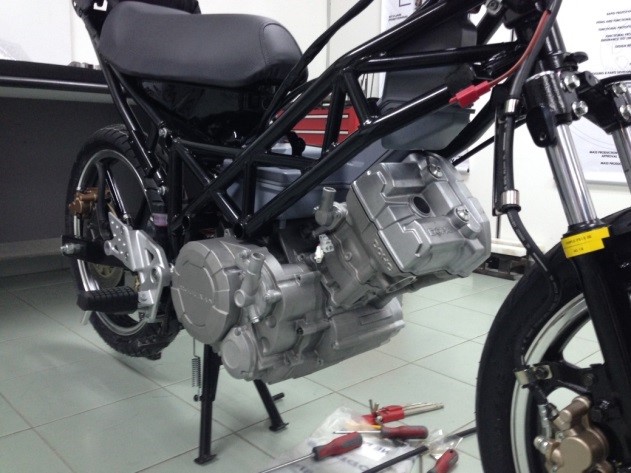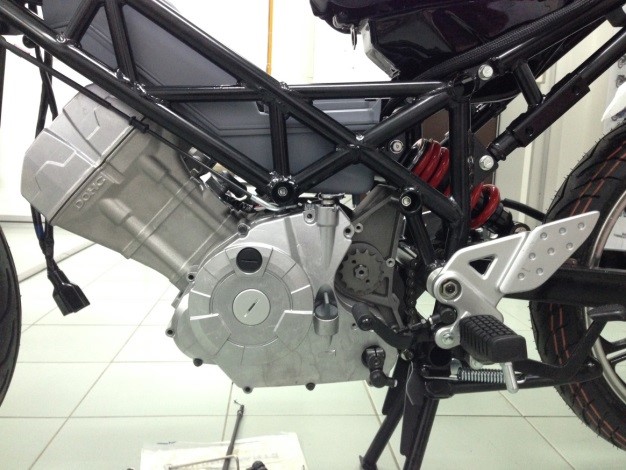Development of a 150cm³ motorcycle engine
 By order of an international motorcycle manufacturer, an engine for driving a motorcycle was developed at the FVT. It is a single-cylinder four-stroke spark ignition engine with a displacement of 150cm³, which is equipped with intake manifold injection, four-valve technology and water cooling. The power transmission is effected via a 6-speed manual transmission, whereby the shifting process should be possible purely manually or semi-automatically, i.e. without manual actuation of the clutch. Another important aspect of the design was the possibility of a modular system for two additional displacement capacities (125 cm³ and 176 cm³), using only a smaller or larger piston and cylinder. The design therefore always had to take into account the boundary conditions of all displacement variants, which inevitably led to design restrictions.
By order of an international motorcycle manufacturer, an engine for driving a motorcycle was developed at the FVT. It is a single-cylinder four-stroke spark ignition engine with a displacement of 150cm³, which is equipped with intake manifold injection, four-valve technology and water cooling. The power transmission is effected via a 6-speed manual transmission, whereby the shifting process should be possible purely manually or semi-automatically, i.e. without manual actuation of the clutch. Another important aspect of the design was the possibility of a modular system for two additional displacement capacities (125 cm³ and 176 cm³), using only a smaller or larger piston and cylinder. The design therefore always had to take into account the boundary conditions of all displacement variants, which inevitably led to design restrictions.
 The overall project, which was carried out over a period of 3.5 years in close cooperation with the customer, comprises the complete layout and design of all engine components in close-to-production design, i.e. taking into account the manufacturing processes (e.g. casting process for housings) as well as the expected part costs and availability of existing components. FVT was responsible for the entire development chain, from pre-design, simulation, design and prototype manufacturing to development on the engine test bench, roller test bench and road operation.
The overall project, which was carried out over a period of 3.5 years in close cooperation with the customer, comprises the complete layout and design of all engine components in close-to-production design, i.e. taking into account the manufacturing processes (e.g. casting process for housings) as well as the expected part costs and availability of existing components. FVT was responsible for the entire development chain, from pre-design, simulation, design and prototype manufacturing to development on the engine test bench, roller test bench and road operation.
 In addition to achieving the target values for emissions (Euro 4) and fuel consumption, proof of series suitability was provided on the basis of an endurance test on the engine test bench on the one hand and within the framework of a vehicle test on the road on the other. The long-term test on the engine test bench involved 500 hours of continuous operation, with the largest proportion of the time being spent at nominal speed. This is due to the application in the target market of the vehicle, which in this displacement category has a high proportion of time spent driving on the motorway at full power. The road test covers 30,000 km without the changing of parts. The project was completed within the scheduled total development time of 3.5 years.
In addition to achieving the target values for emissions (Euro 4) and fuel consumption, proof of series suitability was provided on the basis of an endurance test on the engine test bench on the one hand and within the framework of a vehicle test on the road on the other. The long-term test on the engine test bench involved 500 hours of continuous operation, with the largest proportion of the time being spent at nominal speed. This is due to the application in the target market of the vehicle, which in this displacement category has a high proportion of time spent driving on the motorway at full power. The road test covers 30,000 km without the changing of parts. The project was completed within the scheduled total development time of 3.5 years.